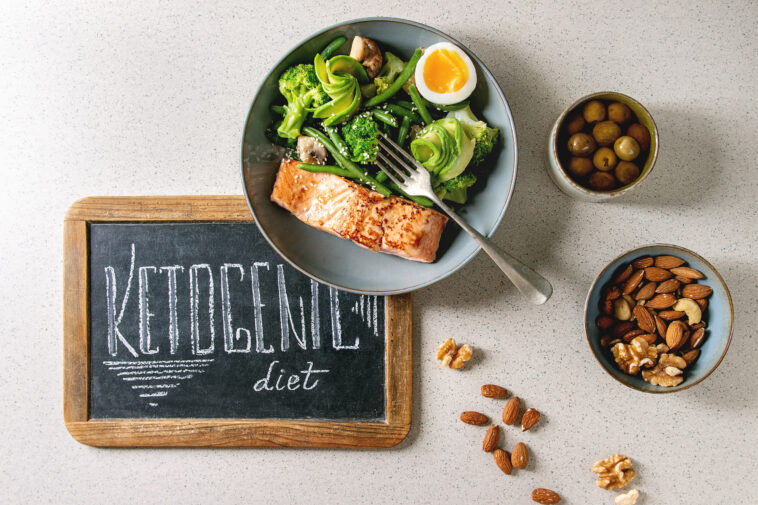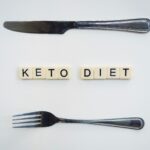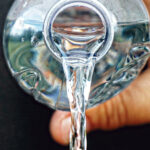Make eating keto a lot easier with this comprehensive keto diet food list—plus learn if it’s the right diet for you.
The keto diet It has a lot of fat, a little protein, and very little carbohydrate. Our preferred energy source is carbohydrate. A ketogenic diet, however, limits carbohydrate consumption to roughly 5%. The recommended energy intake ranges from 5% to 10%. It is derived from carbs. The reduction of carbs is a metabolic condition. ketosis. Ketosis is the state that occurs when the body starts converting stored fat into molecules called ketones. This eliminates the need to consume high-sugar foods by enabling the body to use stored fat for energy. Most of your cells will start using ketone bodies to make energy once you enter ketosis and continue doing so until you eat carbohydrates again.
The main goal of the ketogenic diet was to lessen seizures in young patients with epilepsy. According to Emily Stone, M.S.R.D., “There is now a lot of interest in the diet’s efficacy in helping with other neurological diseases, cancer, diabetes, PCOS, obesity, high cholesterol, and cardiovascular disease.” Humans may consume keto. Become thinner.
Even if you are aware that you should consume low-carb, high-fat, moderate-protein meals, it might be challenging to make the appropriate dietary choices. We have put together a guide that will explain which foods you can consume and which you should stay away from.
The Ketogenic Diet: Foods You Can Eat
Here is a printable list with a variety of foods that are Keto Diet-friendly
This is a list that includes all low-carb keto-friendly foods you can eat.
- Fish and seafood
- Low-carb veggies
- Cheese
- Avocados
- Poultry
- Eggs
- Nuts, seeds, and healthy oils
- Plain Greek yogurt and cottage milk
- Berries
- Unsweetened coffee, tea
- Dark chocolate and cocoa butter
Fish and Seafood
B vitamins can be found in abundance in fish. It is high in protein but devoid of carbohydrates and contains potassium, selenium, and magnesium. Salmon Sardines, mackerel, albacore tuna, and other fatty fish like mackerel all have high concentrations of omega-3 fatty acids. n-3 fatty acids A 2017 analysis found that the substance has been shown to be useful in reducing blood sugar levels and raising insulin sensitivity. Lipids and Health and Disease Innovations in Nutrition Research has revealed in another research that frequent fish eating is associated with a lower risk of acquiring chronic diseases and better mental health. Eat two portions or more of fatty fish every week.
Low-Carb Veggies
Nonstarchy veggies are abundant in nutrients like vitamin C but low in calories and carbohydrates. Antioxidants included in these veggies offer defense against free radicals, which can harm cells. Vegetables having more than 8 grams of net carbohydrates per serving should be avoided. The term “net carbs” describes total carbohydrates less fiber. Together with spinach, it can also be found in broccoli, green beans, bell peppers, and zucchini.
Cheese
Cheese is an excellent choice for ketogenic diets because it is strong in fat and low in carbohydrates. Calcium and protein levels are also elevated. Please be aware that it is a 1-ounce piece of cheddar cheese. There are 6 grams of saturated fat on average. United States Heart Association Keeping your risk of having heart disease low is advised.
Plain Greek Yogurt or Cottage Cheese
Yogurt and cottage cheese are calcium-rich dairy products with significant levels of protein. Greek yogurt, basic, seven ounces 20 grams of protein and about 8 grams of carbs are permitted. Cottage cheese, eight ounces 28 grams of protein and just over 6 grams of carbs are needed. Calcium and protein can both contribute to reducing hunger and boosting feelings of fullness, according to research published in The Journal of Nutrition Nutrients. By selecting higher fat yogurts and cottage cheese, you can feel satiated for longer. Full-fat foods are permitted on the ketogenic diet.
Avocados
Choose heart-healthy fats, such those in avocados. Avocados are rich in potassium, a nutrient that many Americans lack, and monounsaturated fat. a medium avocado cut in half This recipe has 4.5 grams of fiber and 6 grams of total carbohydrates. A 2018 study found that substituting plant oils like avocados for animal fats can lower cholesterol and triglycerides. Journal of Clinical Nutrition in America.
Meat and Poultry
Meat contains lean protein, which is a key component of the ketogenic diet. Fresh meat and poultry are low in carbohydrates and high in selenium, zinc, and other B-vitamins and minerals. Although while processed meats like bacon and sausage are permissible on the keto diet, doing so is not ideal for your health and may raise your risk of getting some cancers. An analysis released in The European Journal of Epidemiology in 2021. Just use chicken, fish, beef, and pork as processed meats.
Eggs
High quantities of protein, B vitamins, minerals, and antioxidants can be found in eggs. two enormous eggs They have more than 12 grams of protein and no carbs. Blood sugar levels are known to be stabilized and to increase with egg consumption. They also contain antioxidants like lutein or zeaxanthin that support eye health, according to a 2020 study. Nutritional Clinical.
Healthy oils, seeds and nuts
Both monounsaturated and polyunsaturated fats, which are good for you, are abundant in seeds and nuts. They also include protein and fiber. Moreover, they have extremely little net carbs. Almond oil Cocoa butter We advise using the oils listed above. a ketogenic diet. Oleic acid-rich olive oil is linked to a lower risk of heart disease. Saturated fats abound in coconut oil. Medium-chain triglycerides (MCTs), which can boost ketone generation, are also present. MCTs are believed to boost metabolism, encourage weight loss, and reduce belly fat. While consuming any healthy fat, always sure to weigh your servings.
1 oz. Carbohydrate count 28 g of nuts and seeds. (Net carbohydrate equals total carbohydrates minus fiber).
- Almonds: 3 g net carbs (6 grams total carbs)
- Brazil nuts: 1 g net carbs (3g total carbs)
- Cashews: 8 g net carbs (9g total carbs)
- Macadamia nuts: 2 g net carbs (Carbohydrates total: 4 g)
- Pecans: 1 g net carbs (Carbohydrates total: 4 g)
- Pistachios: 5 g net carbs (Carbohydrates: Total 8 g)
- Walnuts: 2 g net carbs (4g total carbs)
- Chia seeds: 2 g net carbs (Carbohydrates total 12 g)
- Flaxseeds: Net carbohydrate: 0g (Carbohydrates: Total 8 g)
- Pumpkin seeds 1 g net carbs (Carbohydrates total: 3g)
- Sesame seeds: 3 g net carbs (7 g total carbs)
Berries
Antioxidants are a great way to reduce inflammation and prevent disease. They are low in carbohydrates and high in fiber.
1/2 cup of some berries contains carbs
- Blackberries: 3 g net carbs (Carbohydrates: Total 7g)
- Blueberries: 9g net carbs (Total carbs: 11g)
- Raspberries: 3 g net carbs (Carbohydrates: Total 7 g)
- Strawberries: 3 g net carbs (6 grams total carbs)
Unsweetened coffee and tea
The keto diet allows for the consumption of plain coffee and tea because they contain no carbs, fat, or protein. Drinking 2-3 cups of coffee per day can reduce your risk of getting cardiovascular disease, according to a 2022 study that was published in the European Journal of Preventive Cardiology Research. Tea contains more antioxidants than coffee but less caffeine. The Critical Reviews in Food Science and Nutrition journal released a review in 2015. Tea may aid in weight loss, lowering your risk of stroke or heart attack, and boosting your immunity.
Dark Chocolate and Cocoa Powder
The amount of carbohydrates in these will vary depending on the type of cocoa and how much you consume, so you should carefully read the labels. One of nature’s “superfoods” is cocoa. “superfruit” Due to its strong antioxidant content, dark chocolate may help reduce your chance of developing heart disease. A 2016 study found that flavanols in dark chocolate may help decrease blood pressure and maintain the health of your arteries. Diseases.
The Keto Diet: Foods to Limit
The keto diet is low in carbs, so some foods that have higher carbs may be restricted.
- Grains
- Starchy vegetables and high sugar fruits
- Sweetened yogurt
- Juices
- Honey, syrup and sugar in any form
- Chips and crackers
- Baked goods, including gluten free baked goods
Be not disheartened. According to Stones and Laura Dority RDN, LDN, dietitians with the Keto Hope Foundation, there are no forbidden items when following the ketogenic diet. The amount of carbohydrates you choose to eat depends entirely on how many you eat overall. Spend your carbohydrates. Generally speaking, you should limit your daily carbohydrate intake to 20–40 grams. “But, depending on the person, a carb prescription may range from 10 to 60 grams per day in order to establish ketosis. This amount represents net carbohydrates, or total carbohydrates without fiber “Stone.
People who are active can consume more carbohydrates (perhaps more at the 40-gram level) than someone who is sedentary, says Dority.
The Keto Diet Recommends Limiting High-Carb Foods
Grains
Pasta, bread, crackers, and cereals are all high in carbohydrates. Even new bean-based pastas and whole-wheat pastas are heavy in carbohydrates. Think about several options like spiralized vegetables. Shirataki noodles, which are low in carbohydrates, are another option. Both whole-grain and sugary morning cereals should be avoided. The average slice of bread contains 11 grams of carbohydrates, so you could theoretically eat one slice a day without exceeding your daily carbohydrate allowance, according to Dority. “You could have a TON of vegetables for the same amount of carbs.”
If you consume low-carb foods, you can drink beer in moderation. Although spirits and dry wine are more enticing, they can be used in moderation. alcohol Should not be excessive
Starchy vegetables and high sugar fruits
Because starchy vegetables breakdown more quickly than fiber, they should be avoided when following a ketogenic diet. They include beets, potatoes, and sweet potatoes. Berries and other high-sugar fruits should be avoided since they contain more carbohydrates and cause blood sugar to rise more quickly than berries do. (View the complete list.) Fruits with minimal net carbs are listed from least to most).
High-sugar fruits have high carbohydrate counts:
- Banana (1 medium): 24 grams net carbs (Carbohydrates total 27 g)
- Raisins (1 oz./28 g): 21 g net carbs (Carbohydrates total: 22 g)
- Dates (2 large): 32g net carbs (36 g total carbs)
- Mango (1 cup): 22g net carbs (Carbohydrates: 25 g)
- Pear (1 medium): 21g net carbs (Carbohydrates total 27 g)
Carbohydrate counts for starchy vegetables
- Corn (1 cup: 32 g net carbs, 36 g total carbs
- Potato (1 medium): 33g net carbs (37g total carbs).
- Sweet potato (1 medium): 20g net carbs (24g total carbs).
- Beets (1 cup, cooked), 14 g net carbs (17.6 g total carbohydrates).
Sweetened yogurts
To limit added sugars (aka carbs), stick to plain yogurt. Greek yogurt is richer in protein than regular yogurt and has lower levels of carbohydrates.
Juices
Fruit juice—natural or not—is high in fast-digesting carbs that spike your blood sugar. Keep it water.
Honey, syrup, and sugar in all forms
Limit sugar, honey and maple syrup, as they are high in carbs and low in nutrients.
Chips and crackers
Chips, crackers, and other processed, grains-based snacks foods should be limited as they are high in carbs and low in fiber.
Bakery products that are gluten free
Gluten-free does NOT mean carb-free. Many gluten-free muffins, breads, and muffins have the same amount of carbs as traditional baked goods. They may lack fiber.
Keto Diet Foods and Drinks
You may eat any meal that is allowed on the keto diet as long as you reach your daily carbohydrate objectives. Some foods fall between between high-carb and low-carb, though.
Milk
Milk is a good source of calcium, potassium, and many other B vitamins. One cup of milk contains 12g sugar (lactose). You can substitute almond, coconut, and other low-carb milks.
Beans and Legumes
Beans and legumes are high-fiber and high-protein and can be part of a heart healthy diet. They are also high carbohydrate. You can include them in small quantities on a ketogenic diet. They can however consume large amounts of your daily carbohydrate intake.
Pros of the Ketogenic diet
According to Dority, there is strong evidence to support the use of the ketogenic diet in those with epilepsy who experience drug-resistant seizures. At least temporarily, weight loss is a result of the diet. According to Dority, “Recent research has shown promise in conditions like autism, traumatic brain injury, brain tumors, migraines, and Alzheimer’s, as well as research on ketogenic diets and type 2 diabetes, including reducing insulin needs, fasting blood sugar levels, lowering A1C, and achieving significant weight loss.” Further research is required to back up these statements. Only those who are able to follow the limited diet will profit from it.
Cons of the Ketogenic diet
According to Stone, “it is challenging to achieve nutritional demands while following keto, like most very restrictive diets.” It frequently has unpleasant side effects, including as constipation and the “keto flu,” and its long-term health effects are unclear. High-restrictive eating plans can be challenging to follow and might harm a person’s relationship with food. Discover more about the numerous negative effects of the ketogenic diet. This includes hair loss and poor breath. poor intestinal health.
The Conclusion
There isn’t a fix that works for everyone. Working with a dietician will help you make sure you are getting the necessary nutrients and keeping your body in ketosis. While some studies suggest the ketogenic diet helps treat a variety of ailments, most people find it challenging to stick to it over the long haul. Further research is required since the long-term consequences on general wellness are not well understood. Also, at Healthy Eating Avoiding healthy foods like whole grains, legumes, fruits, and veggies is not a good idea. In the event that you choose to take the keto way, a dietician can assist you in creating a plan.



